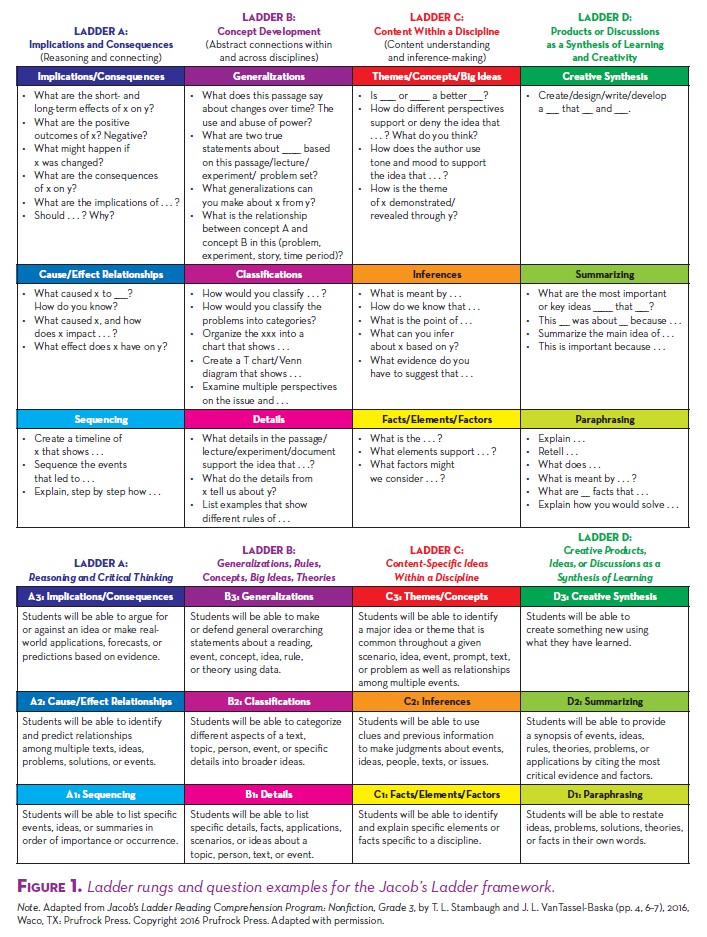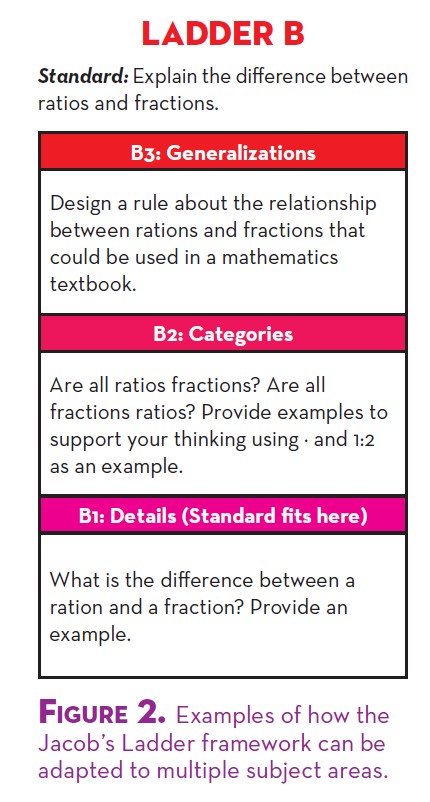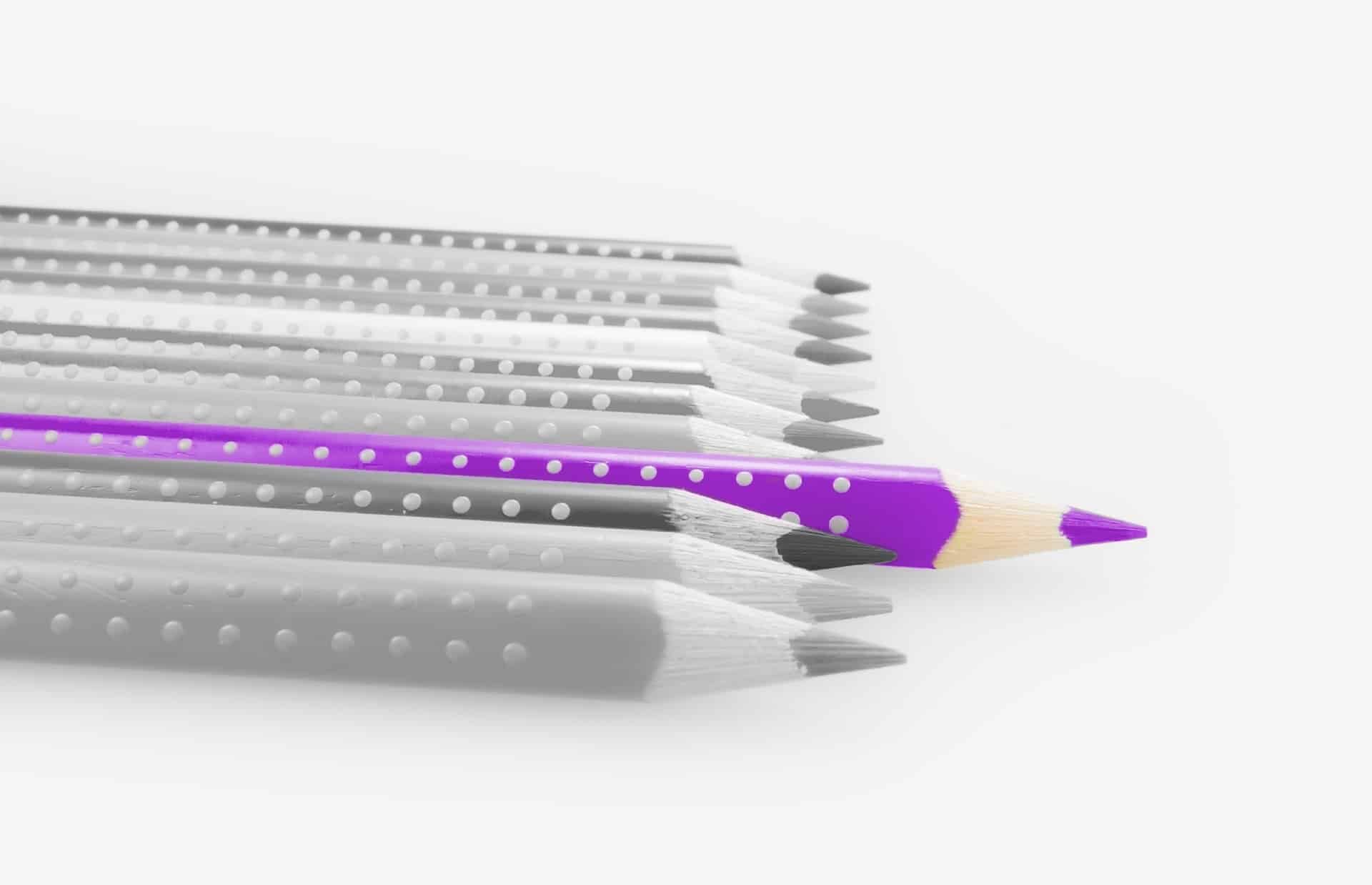Scaffolding as an educational strategy is sometimes thought to be reserved only for students below grade level. However, students who are grappling with content that is advanced beyond their current readiness level need a support structure in place in order to attain higher levels of achievement and continue on their path toward developing expertise.
What is scaffolding? A scaffold is “a supportive framework” or “a temporary or movable platform to stand or sit on when working at a height above the floor or ground” (Merriam-Webster.com, n.d., para. 1). In education, instructional scaffolds serve as a framework to support learning when students are working at a “height” that is above their readiness. Instructional scaffolds allow students to perform a skill or a task they would not otherwise be able to do without that support. In general education, instructional scaffolding approaches can take on many forms, such as providing exemplars before engaging students in a task demand, asking lower to higher level questions to guide problem solving or critical thinking, modeling thinking, reviewing vocabulary or providing background knowledge before discussing a difficult text, or adjusting the level of difficulty of a task over time—slowly building to more advanced levels of content and understanding (IRIS Center, 2005). Scaffolds can be created for content, material, or tasks (IRIS Center, 2005).
Scaffolds are not intended to be a huge jump, but a gradual climb. The amount of scaffolding a child needs is dependent upon his or her readiness, experience, and the complexity of the required task. Scaffolding is not permanent. Once students can consistently and successfully perform the intended task, the scaffolds are removed. This concept may be likened to training wheels on a bicycle. As students become more competent riders, the training wheels are removed, yet students continue to ride their bike successfully without the support. Hammond and Gibbons (2005) explained that the decisions to add or remove instructional training wheels take thoughtful practice. They cited specific criteria that necessitate the need for scaffolding:
- Students could not succeed without the teacher’s intervention.
- The teacher aims for some new level of independent competence on the students’ part.
- The teacher has the learning of some specific skill or concept in mind.
- There must be evidence of students successfully completing the particular task at hand.
- There must also be evidence that learners are now able to go on to deal independently with subsequent related tasks or problems. (Mercer, 1994, as cited in Hammond & Gibbons, 2005, p. 11)
The authors identified two objectives of scaffolding, including (a) to empower students to work independently and successfully on their own given a particular task and (b) to apply scaffolding techniques to newly encountered situations, tasks, or problems (Hammond & Gibbons, 2005).
Scaffolding of instruction is more commonly cited as a strategy for struggling learners, even though scaffolds are important for any student who needs assistance climbing to higher levels of achievement. Once students consistently and successfully perform tasks at an independent level without the need for scaffolds, they need to move to a higher platform. As this occurs, more scaffolding is necessary to obtain a new level of content acquisition. Many of us are familiar with Vygotsky and the Zone of Actual and Proximal Development (Vygotsky, 1978). Vygotsky (1978) argued that a student who solves a problem or task independently has already learned that task—it is his or her Zone of Actual Development. It is yesterday’s learning. A student is in the Zone of Proximal Development when he or she requires support from a “more knowledgeable other” as he or she is unable to perform the task or meet the intended goal independently. As such, if gifted students are consistently provided tasks that they can easily and independently perform without support, are they learning? Maybe not. We want to celebrate students’ independence when accomplishing tasks but if students rarely require a scaffold, then perhaps the tasks are not at a level that is high enough.
In order for gifted students to continue learning, the content, processes, and tasks need to be advanced enough that the student actually needs an instructional support in order to successfully and independently achieve the intended goal. This means that we must accelerate the content and adjust the concepts and thinking models or processes (VanTassel-Baska & Little, 2017). Although gifted students show higher levels of critical thinking in general (Kettler, 2014; Stambaugh, 2007), they still benefit from the explicit teaching of thinking models (Rogers, 2007) and the deliberate use of frameworks and models over time (VanTassel-Baska & Stambaugh, 2007). One such framework to support deliberate scaffolding is the Jacob’s Ladder Reading Comprehension Program. This framework was originally designed to support skill development for students from low-income households who, with intentional support and scaffolds, could attain higher levels of achievement and thinking. Since its inception, the framework has been successfully used in a variety of content domains and with students from a variety of backgrounds and ability levels. Although there are many different methods of scaffolding, research shows that applying the Jacob’s Ladder framework as one approach yields positive academic gains for students. Research from a quasi-experimental design study in reading with just under 500 students suggests that when teachers were provided with the appropriate professional development and modeling of the framework, students in the experimental group showed significant and important gains in reading comprehension and critical thinking (Stambaugh, 2007).
The Jacob’s Ladder program is a compilation of instructional scaffolding models or ladder skills, intended to move students to higher levels of critical thinking, concept development, inference-making and the development of thematic ideas, or creative production. Each ladder stands alone and focuses on a different thinking component. Students “climb” each ladder by answering lower level to higher level questions as they move toward deeper understanding of a content area. Examples of ladders and question stems for each rung of a ladder are provided in Figure 1. Ladder A focuses on critical thinking and asks students to determine implications and consequences of various issues or ideas. By leading students through sequencing and cause-and-effect activities, they learn to draw implications and consequences from readings, science experiments, or historical analyses. Ladder B focuses on making generalizations and developing concepts. Students first learn to provide details and examples, and then move to classifying and organizing those details in order to make generalizations or statements about a concept or idea that would be true in most situations or disciplines. Ladder C focuses on main ideas, themes, and conceptual understandings. Students begin by considering facts, details, or elements of a literary text, problem, situation, or task and, then, make inferences about the findings, events, or text as they determine thematic ideas and deeper content-specific understandings. Ladder D focuses on creative synthesis by leading students through paraphrasing or retelling facts, events, or plotlines, and summarizing key ideas before asking new questions or creating original products. Although the Jacob’s Ladder model was originally intended for use with reading comprehension, teachers can expand this framework to implement the key elements of each ladder across multiple content areas to differentiate instruction for gifted and advanced learners, thus applying accelerated content and scaffolding as a way to support learning. A few examples are included in the next section.

This framework can be adapted in a variety of ways to differentiate and scaffold instruction as students are presented with accelerated content and processes that require them to draw upon the expertise of others to obtain higher levels of thinking and content acquisition. After determining which ladder and rung best matches the standard and student content acquisition, teachers can adjust the complexity of the questions and tasks by providing activities that move students to higher levels (i.e., rungs) of instruction as they show mastery of lower level rungs. For example, if a standard requires students to list or sequence the events that led to the signing of the Declaration of Independence, we might plot this as a Ladder A sequencing task. Students who know or could perform this task quickly would be provided with a replacement task at the next rung of the ladder (i.e., cause and effect). They may be asked to discuss the cumulative effects of two or three key events (e.g., Stamp Act, Intolerable Acts, Boston Tea Party) before moving to the highest rung of the ladder in which they debate the positive and negative long-term implications of these events on future decisions. If differentiating in math and the standard requires students to understand ratios and fractions, one might begin with Ladder B because definitions may be seen as details or elements of a problem or concept. After defining ratios and fractions and providing examples of each (bottom rung), students could defend whether or not all ratios are fractions (categorization/classification) by explaining the similarities and differences between ½ and 1:2. Then, they would move to the highest rung of Ladder B and create a rule about the relationship between ratios and fractions that could be used in a mathematics textbook. By plotting where a standard fits on a ladder rung and then adjusting the instruction by differentiating questions and tasks, teachers have a guide for scaffolding up or down as necessary to support student learning.
Scaffolding accelerated content or advanced processes is another way to use the Jacob’s Ladder framework. This use was the original intent of the framework. Using this method, teachers present accelerated content, tasks, or questions that are above the student’s level of readiness. Students then climb up and down the ladder, building upon previously learned skills to reach the most accelerated or advanced content at the highest rungs. For example, if students are expected to make inferences and determine how a writer develops a theme, Ladder C could be applied because of the focus on determining and justifying themes being the highest rung. Teachers would first select a more advanced text based on each student’s reading level (e.g., accelerate the resource first). Assuming the text is sophisticated enough that students need additional support, they would begin at the bottom rung of Ladder C, examining literary elements such as symbols, metaphors, images, and structure. Then students would make inferences based on key passages before discussing how the use of literary elements and key phrases develop the theme. In this way they would climb the ladder with a challenging text, breaking it down from literary elements, to inference-making, to how elements and inferences interact to support a theme.
Similarly, in science, if students are asked to create an experiment for a science fair project (Ladder D–creative synthesis), they first need to read informational texts and gain an understanding of the construct they want to pursue by paraphrasing multiple articles and reviewing ideas about their topic (bottom rung). Then, moving up to the second rung of the ladder, students summarize the information they acquired from multiple articles and determine new questions from the literature that need exploration, including patterns and issues that have emerged. Finally, at the highest rung of Ladder D, they would create a testable question (creative synthesis) and design an experiment. As illustrated in Table 1, the sentence stem for the top rung of the Creative Synthesis ladder states: “create a __ that and ___” (Stambaugh, 2013). These criteria are set based on the standards, outcomes, or purposes of the task or product. This stem is designed to focus a task, add depth, and support the development of expertise—as criteria and parameters still need to be met as part of creative production. Therefore, instead of simply asking students to design a science experiment, parameters or criteria would be added so that students would be asked to design an experiment that solves a problem, such as overpopulation of invasive species, that is scalable, affordable, and does not negatively affect the balance of the ecosystem. In social studies, if students are reading the Gettysburg Address and need support interpreting the text (assuming they are unable to accomplish the highest rungs without scaffolding), then they would paraphrase certain selections of the speech (Ladder D, bottom rung), summarize key ideas (Ladder D, middle rung), and then create an editorial response to the speech that provides an accurate interpretation of the meaning given the context of the day and includes at least two different perspectives (Ladder D, top rung), thereby demonstrating a deeper level of understanding than they could have obtained without support. Figure 2 provides an example of how ladders can be modified for other content area standards.

Student readiness is a critical consideration when using the framework. If students do not need scaffolding and they can independently and successfully perform the most advanced tasks from the ladder without support, then accelerated content or more complex tasks need to be considered. Likewise, just as teachers can adjust questions to differentiate using the ladder framework and mapping standards to the rungs, students can internalize the ladder processes and apply the processes to their own learning. For example, if they know they are uncertain about the implications and consequences of a given problem or scenario (Ladder A), then they can apply the ladder structure on their own and go back to sequence events, determine cause and effect relationships, and, then, using that information, consider short and long-term consequences.
Whether standards are mapped to ladders as part of a differentiated approach or accelerated content and processes are scaffolded, students and teachers are applying deliberate approaches to guide student thinking. As new information is learned and scaffolds are no longer necessary, the process begins again with more challenging tasks, resources, and accelerated content. In this way, all students can learn something new every day and have opportunities to work in the Zone of Actual and Proximal Development as they continue on a path toward developing expertise. Thus, as noted in the headline of this article, scaffolding of instruction is necessary for gifted students, too.
Note: Portions of the article were adapted from Jacob’s Ladder Reading Comprehension Program: Grades K–1 (2nd ed., pp. 1–34) by T. Stambaugh and J. VanTassel-Baska, 2017, Waco, TX: Prufrock Press. Copyright 2017 by Prufrock Press. Adapted with permission.
References
Hammond, J., & Gibbons, P. (2005). Putting scaffolding to work: The contribution of scaffolding in articulating ESL education. Prospect, 20(1), 6–30.
The IRIS Center. (2005). Providing instructional supports: Facilitating mastery of new skills. Retrieved on from https://iris.peabody.vanderbilt.edu/module/sca/
Mercer, N. (1994). Neo-Vygotskian theory and classroom education. In B. Steirer & J. Maybin (Eds.), Language, literacy and learning in educational practice (pp. 92–110). Clevedon: Multilingual Matters.
Kettler, T. (2014). Critical thinking skills among elementary school students comparing identified gifted and general education student performance. Gifted Child Quarterly, 58, 127–136.
Larkin, M. (2002). Using scaffolded instruction to optimize learning. Retrieved from http://www.vtaide.com/png
Merriam-Webster.com. (n.d.). Scaffold. Retrieved from https://www.merriam-webster.com/dictionary/scaffold
Rogers, K. (2007). Lessons learned about educating the gifted and talented: A synthesis of the research on educational practice. Gifted Child Quarterly, 51, 382–396.
Stambaugh, T. L., & VanTassel-Baska, J. L. (2016). Jacob’s Ladder Reading Comprehension Program: Nonfiction, Grade 3. Waco, TX: Prufrock Press.
Stambaugh, T. (2007). Effects of the Jacob’s Ladder Reading Comprehension Program on reading comprehension and critical thinking skills of third, fourth, and fifth grade students in Title I schools (Unpublished doctoral dissertation). William & Mary, Williamsburg, VA.
VanTassel-Baska, J., & Little, C. (2017). Content-based curriculum for high-ability learners (3rd ed). Waco, TX: Prufrock Press.
VanTassel-Baska, J., & Stambaugh, T. (2007). What works: 20 years of curriculum development and research for advanced learners. Waco, TX: Prufrock Press.
Vygotsky, L. S. (1978). Mind in society: The development of higher psychological processes. M. Cole et al. (Eds.). Cambridge, MA: Harvard University Press.
Tamra Stambaugh, Ph.D., is an associate research professor in special education and executive director of Programs for Talented Youth at Vanderbilt University. She received her Ph.D. in Educational Policy, Planning, and Leadership from the College of William and Mary where she worked at the Center for Gifted Education. Stambaugh’s research interests focus on gifted students living in rural settings, students of poverty, and curriculum and instructional interventions that promote gifted student learning.


![iStock-836476604 [Converted] iStock-836476604 [Converted]](https://tempo.txgifted.org/wp-content/uploads/elementor/thumbs/iStock-836476604-Converted-qyy1ojh9zi8fgy36un5338g80vwc3i2pvteckd7qu0.jpg)




